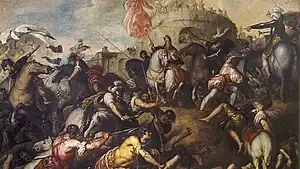Siege of Chartres (911)
The siege of Chartres was part of the Viking incursions in France. In 911, the Viking Rollo led a siege on the city of Chartres, which had previously been raided and burned by Vikings in 858.[1] The siege resulted in the defeat of the Viking forces. After negotiations with Charles the Simple, Rollo was then granted the Duchy of Normandy in exchange for loyalty to the kingdom of West Francia.
| Siege of Chartres | |||||||||
|---|---|---|---|---|---|---|---|---|---|
 Painting of the siege, 1618, by Padovanino | |||||||||
| |||||||||
| Belligerents | |||||||||
| West Franks | Vikings | ||||||||
| Commanders and leaders | |||||||||
|
Richard, Duke of Burgundy Robert I of France Charles the Simple Bishop Gantelme | Rollo | ||||||||
| Strength | |||||||||
| 8,000 | 20,000 | ||||||||
| Casualties and losses | |||||||||
| Light | 6,000–7,000 | ||||||||
The Viking incursions into Francia began in 820 CE. The raids were frequent and devastating, reaching Paris multiple times. Preceding the battle at Chartres, Vikings, most likely led by Rollo, had been conducting raids into central Francia in 910. Earlier in 876 they had seized Rouen, which had established a permanent Viking foothold on the region.[2][3]
The siege
Since 858, the city of Chartres had undergone no direct attacks.[1] In the 53 years between the sieges, the city had been fortified with trapezoidal fortifications. Beginning in April of May of 911, Rollo launched a siege of the city, following a campaign of raiding across the north of Francia. The Norsemen attacked the city with the artillery of the time, but did not succeed before the arrival of a French army in July of that year.[1]
The French army was primarily led by Richard, Duke of Burgundy, and Robert I of France, and was composed primarily of Burgundians, Aquitanians, and the French. Richard attacked Rollo and his forces, and they met in battle. According to legend, the bishop brought out the Virgin's Tunic, a holy relic supposedly worn by the Virgin Mary, which blinded the Norsemen and led the French to victory. In reality, the veil may have served as a distraction that enabled the French to gain the upper hand over the Norsemen. The French successfully managed to encircle and capture the majority of the Norse army, but Rollo and a small company escaped.[1]
Because of Rollo's escape, the raids and occupation of Rouen by the Norsemen would continue despite the loss. The French opened negotiations with Rollo to end the violence, which would lead to the Treaty of Saint-Clair-sur-Epte.[4]
In 1618 the Italian painter Padovanino painted a version of the event which now hangs in the Pinacoteca di Brera.[5]
Treaty of Saint-Clair-sur-Epte
The treaty of Saint-Clair-sur-Epte was agreed on between Rollo and Charles the Simple, who met personally to discuss the terms. Rollo was granted the land around the mouth of the Seine and Rouen. This marked the establishment of the Duchy of Normandy.[3] In exchange for this land, Rollo promised his loyalty to West Francia, religious conversion to Christianity, and a promise to defend the Seine's estuary from other Viking raiders.
References
- The date of the battle is hard to pin down because of various author's unreliability for the information. Dudo especially has a history of Rollo that embellishes many of the tales. The date and event of the battle is confirmed however by the Annals of Ste. Colobe of Sens. As such this article has given the date of 20 July 911 listed therein.
- Lair, Jules (1901). Le Siège de Chartres Par Les Normands (911) (in French). ISBN 2-01-451148-9. OCLC 1254663604.
- Douglas, D. C. (1942). "Rollo of Normandy". The English Historical Review. LVII (CCXXVIII): 426–428. doi:10.1093/ehr/LVII.CCXXVIII.417.
- "Norman people". Encyclopedia Britannica. 2022-12-27. Retrieved 2023-01-19.
- Palgrave, Francis Turner (1851). The History of Normandy and of England. Vol. 1. pp. 671–680. ISBN 978-1446034811.
- "The Victory of the Carnutes over the Normans". Pinacoteca di Brera. Retrieved January 18, 2023.